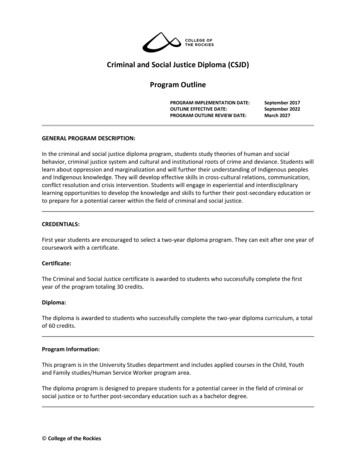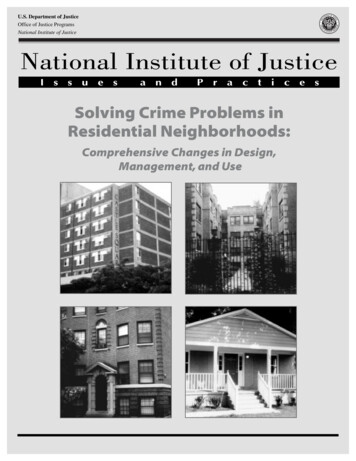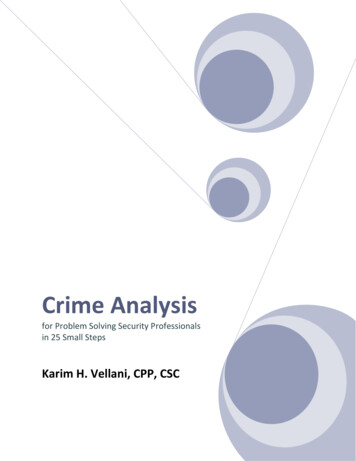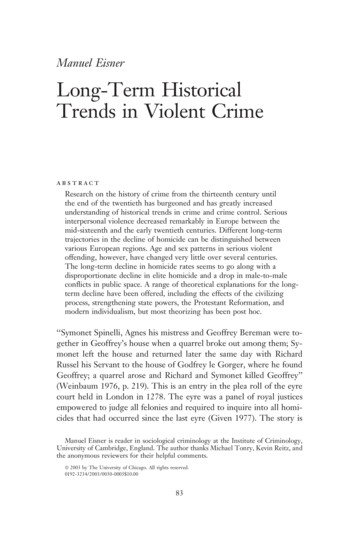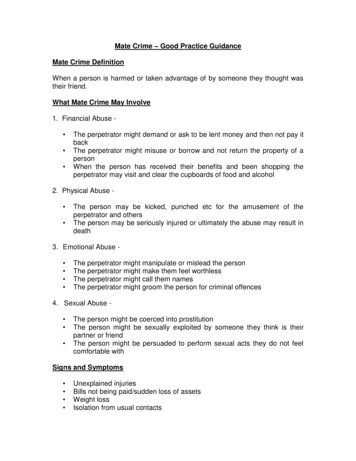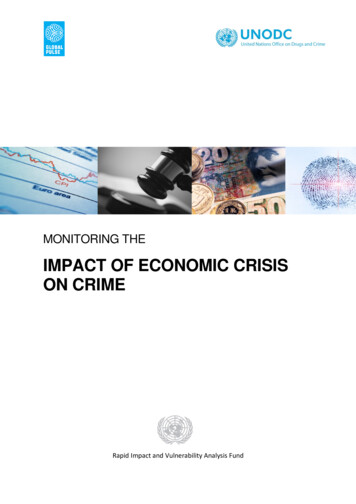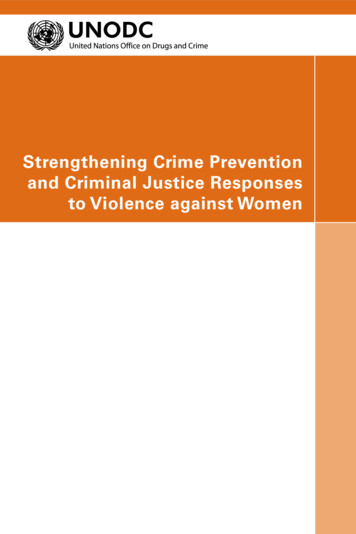
Transcription
Strengthening Crime Preventionand Criminal Justice Responsesto Violence against Women
This publication has been prepared in cooperation with the Thailand Institute of Justice
UNITED NATIONS OFFICE ON DRUGS AND CRIMEViennaStrengthening Crime Preventionand Criminal Justice Responsesto Violence against WomenUNITED NATIONSNew York, 2014
United Nations, April 2014. All rights reserved, worldwide.The designations employed and the presentation of material in this publication donot imply the expression of any opinion whatsoever on the part of the Secretariat ofthe United Nations concerning the legal status of any country, territory, city or area,or of its authorities, or concerning the delimitation of its frontiers or boundaries.This publication has not been formally edited.Publishing production: English, Publishing and Library Section, United NationsOffice at Vienna.
ContentsPageIntroduction . . . . . . . . . . . . . . . . . . . . . . . . . . . . . . . . . . . . . . . . . . . . . . .1Part one. pdated Model Strategies and Practical Measures on theUElimination of Violence against Women in the Field of CrimePrevention and Criminal Justice. . . . . . . . . . . . . . . . . . . . . . . . . . . . . .7Part two.Blueprint for Action: an Implementation Plan for Criminal JusticeSystems to Prevent and Respond to Violence against Women . . . . . .29A.Guiding principles. . . . . . . . . . . . . . . . . . . . . . . . . . . . . . . . . . .33B.Legal framework. . . . . . . . . . . . . . . . . . . . . . . . . . . . . . . . . . . .37C. A coordinated and integrated criminal justice response. . . . . .45Section one.Criminal justice agencies. . . . . . . . . . . . . . . . . .45Section two.The criminal justice process . . . . . . . . . . . . . . .54Section three. Elements for an integrated and coordinatedcriminal justice response. . . . . . . . . . . . . . . . . .92D.97Data collection and analysis, monitoring and evaluation. . . . .AnnexList of selected United Nations instruments and resources. . . . . . . . . 103iii
IntroductionViolence against women1 is one of the most widespread violations of humanrights. It can include physical, sexual, psychological and economic abuse,and it cuts across boundaries of age, race, culture, wealth and geography.This type of violence has far-reaching consequences, harming families andcommunities. Gender-based violence not only violates human rights but alsohampers productivity, reduces human capital and undermines economicgrowth. Although rates of women exposed to violence vary from one regionto the other, statistics indicate that violence against women is a universalphenomenon and women are subjected to different forms of violence bothwithin and outside their homes.While progresses have been made by some countries in certain areas, thereare still many impediments to effectively prevent and eradicate violence againstwomen. As stated by the former Executive Director of the United NationsEntity for Gender Equality and the Empowerment of Women (UN-Women),Michelle Bachelet, “ Today, 160 countries have laws to address violenceagainst women yet at all too often, the women subjected to violence areviolated twice—the first time when they are victims of violence, and thesecond time when they seek, and do not find, the justice and services theyare entitled to. All too often the rate of trials and sanctions for acts ofviolence against women is very low, and when perpetrators are held accountable, they are punished for lesser crimes given shorter and lightersentences ”.2Due to loopholes in criminal legislation, poor enforcement of criminal lawsand regulations, lack of proper capacity in the criminal justice system, diminishing and discriminatory attitudes among relevant professionals and lack ofsufficient and sustainable dedicated resources, in many countries the justicechain is still failing women victims of violence.3 This failure results in ahigh level of cases of violence going unreported and unprosecuted, in a1Except where otherwise specified, the term “women” encompasses “girl children”.Speech on “Gender-motived killings of women and girls, including femicide” New York,12 March 2013.3UN Women, Progress of the World’s Women 2011–2012: In pursuit of Justice (2011).21
2 Strengthening Crime Prevention and Criminal Justice Responses to Violence against Womenprofound lack of confidence and trust in the criminal justice institutions aswell as in a high percentage of victims whose needs for assistance, protection and redress are neither recognized nor met.The present publication aims at supporting efforts to address these challengesand provides countries with comprehensive guidance on how to improve, bothfrom a normative and operational perspective, the response of their criminaljustice system to violence against women. This publication was producedpursuant to the request of the General Assembly that the United NationsOffice on Drugs and Crime (UNODC) intensify its efforts to ensure thewidest possible use and dissemination of the updated Model Strategies andPractical Measures on the Elimination of Violence against Women in theField of Crime Prevention and Criminal Justice, adopted by the GeneralAssembly in December 2010.4Part one of the publication contains the text the updated Model Strategiesand Practical Measures, which constitute a comprehensive policy frameworkto assist States in developing responses and carrying out actions to eliminateviolence against women and to promote equality between men and womenwithin the criminal justice system.Part two of the publication, entitled Blueprint for Action: an ImplementationPlan for Criminal Justice Systems to Prevent and Respond to Violenceagainst Women, is designed to provide practical and specific support tocountries in implementing the recommendations and measures contained inthe updated Model Strategies and Practical Measures.The updated Model Strategies and Practical Measures provide a series ofbroad recommendations for countries organized around the following themes:criminal law; criminal procedure; police, prosecutors and other criminal justice officials; sentencing and corrections; victim support and assistance;health and social services; training; research and evaluation; crime preventionmeasures; and international cooperation.In adopting the updated Model Strategies and Practical Measures, theGeneral Assembly urged Member States to evaluate and review their legislation and legal principles, procedures, policies, programmes and practicesrelating to crime prevention and criminal justice matters, drawing uponthe newly adopted instrument, and determine if they are adequate to preventand eliminate violence against women. Member States were also called upon4General Assembly resolution 65/228, annex.
Introduction 3to advance effective crime prevention and criminal justice strategies thataddress violence against women, including strategies aimed at preventingre-victimization.The Blueprint for Action was developed with the support of the ThailandInstitute of Justice and relevant United Nations entities, such as theUnited Nations Entity for Gender Equality and the Empowerment of Women(UN-Women) and the Office of the High Commissioner for Human Rights,and with the substantive input and feedback provided by international expertsgathered in Bangkok from 14 to 17 June 2013. It provides a framework fordeveloping national implementation plans for the criminal justice system torespond to violence against women. The framework is purposefully broadto recognize that violence against women manifests itself in different forms,such as domestic violence, sexual violence, sexual harassment, stalking,human trafficking, forced prostitution, forced and early marriage, femalegenital mutilation, crimes against women committed in the name of honourand other harmful practices, and gender-related killings of women, as wellas to acknowledge the fact that this type of violence happens in differentsettings, including conflict and post conflict settings.While different forms of violence against women will likely require a moretailored response, the Blueprint for Action can serve as a reference documentbeing based on the underlying commonalities of this type of violence: thegendered nature of the violence and the need to address the victims’ wholeexperience. Recognizing that violence against women differs from othercrimes due to its gendered nature, and needs to be handled in a unique andcoordinated manner, the Blueprint for Action emphasizes the need of a coordinated and integrated criminal justice response for the prevention of violence against women, protection and empowerment of victims and prosecutionof the perpetrators of violence.
PART ONE.UPDATED MODEL STRATEGIESAND PRACTICAL MEASURES ON THEELIMINATION OF VIOLENCE AGAINSTWOMEN IN THE FIELD OF CRIMEPREVENTION AND CRIMINAL JUSTICE
Updated Model Strategies and Practical Measureson the Elimination of Violence against Women in theField of Crime Prevention and Criminal Justice1Preamble1. The multifaceted nature of violence against women necessitates differentstrategies to respond to the diverse manifestations of violence and the various settings in which it occurs, both in private and in public life, whethercommitted in the home, the workplace, educational and training institutions,the community or society, in custody or in situations of armed conflict ornatural disaster. In the updated Model Strategies and Practical Measures onthe Elimination of Violence against Women in the Field of Crime Preventionand Criminal Justice, the importance of adopting a systematic, comprehensive, coordinated, multisectoral and sustained approach to fighting violenceagainst women is recognized. The practical measures, strategies and activities described below can be introduced in the field of crime prevention andcriminal justice to address violence against women. Except where otherwisespecified, the term “women” encompasses “girl children”.2. Violence against women exists in every country in the world as apervasive violation of human rights and a major impediment to achievinggender equality, development and peace. Violence against women is rootedin historically unequal power relations between men and women. All formsof violence against women seriously violate and impair or nullify theenjoyment by women of all human rights and fundamental freedoms andhave serious immediate and long-term implications for health, includingsexual and reproductive health, for example through increased vulnerabilityto HIV/AIDS, and public safety, and have a negative impact on the psychological, social and economic development of individuals, families, communities and States.1General Assembly resolution 65/228, annex.7
8 Strengthening Crime Prevention and Criminal Justice Responses to Violence against Women3. Violence against women is often embedded in and supported by socialvalues, cultural patterns and practices. The criminal justice system andlegislators are not immune to such values and thus have not always regarded violence against women with the same seriousness as other types ofviolence. Therefore, it is important that States strongly condemn all formsof violence against women and refrain from invoking any custom, traditionor religious consideration to avoid their obligation with respect to its elimination and that the criminal justice system recognize violence againstwomen as a gender related problem and as an expression of power andinequality.4. Violence against women is defined in the Declaration on the Eliminationof Violence against Women2 and reiterated in the Platform for Action adoptedby the Fourth World Conference on Women3 to mean any act of genderbased violence that results in, or is likely to result in, physical, sexual orpsychological harm or suffering to women, including threats of such acts,coercion or arbitrary deprivation of liberty, whether occurring in public orin private life. The updated Model Strategies and Practical Measures buildon the measures adopted by Governments in the Platform for Action, whichwas adopted in 1995 and subsequently reaffirmed in 2000 and 2005, theModel Strategies and Practical Measures on the Elimination of Violenceagainst Women in the Field of Crime Prevention and Criminal Justice adopted in 1997,4 and relevant General Assembly resolutions, including resolutions 61/143 and 63/155, bearing in mind that some groups of women areespecially exposed and vulnerable to violence.5. The updated Model Strategies and Practical Measures specificallyacknowledge the need for an active policy of mainstreaming a gender perspective in all policies, programmes and practices to ensure gender equalityand equal and fair access to justice, as well as establishing the goal of genderbalance in all areas of decision making, including those related to the elimination of violence against women. The updated Model Strategies and Practical Measures should be applied as guidelines in a manner consistent withrelevant international instruments, including the Convention on the Elimination of All Forms of Discrimination against Women,5 the Convention on theRights of the Child,6 the Optional Protocol to the Convention on the Rights2General Assembly resolution 48/104.Report of the Fourth world Conference on Women, Beijing, 4-15 September 1995 (United Nationspublication, Sales No. E.96.IV.13), annex II.4Resolution 52/86, annex.5United Nations, Treaty Series, vol. 1249, No. 20378.6United Nations, Treaty Series, vol. 1577, No. 27531.3
Updated Model Strategies and Practical Measures on the Elimination of Violence against Women 9of the Child on the sale of children, child prostitution and child pornography,7the International Covenant on Civil and Political Rights,8 the Protocol toPrevent, Suppress and Punish Trafficking in Persons, Especially Women andChildren, supplementing the United Nations Convention against Transnational Organized Crime,9 the Rome Statute of the International CriminalCourt10 and the Guidelines for the Prevention of Crime,11 with a view tofurthering their fair and effective implementation. The updated Model Strategies and Practical Measures reaffirm the commitment of States to promotegender equality and empower women with a view to meeting Goal 3 of theMillennium Development Goals.6. The updated Model Strategies and Practical Measures should be endorsedby national legislation and implemented by Member States and other entitiesin a manner consistent with the right to equality before the law, while alsorecognizing that gender equality may sometimes require the adoption ofdifferent approaches that acknowledge the different ways in which violenceaffects women as compared to men. Member States should ensure thatwomen have equal protection under the law and equal access to justice inorder to facilitate efforts by Governments to prevent and sanction acts ofviolence against women through comprehensive and coordinated policiesand strategies, and to deal with all forms of violence against women withinthe criminal justice system.7. The updated Model Strategies and Practical Measures recognize thatcrime prevention and criminal justice responses to violence against womenmust be focused on the needs of victims and empower individual womenwho are victims of violence. They aim to ensure that prevention and intervention efforts are made to not only stop and appropriately sanction violenceagainst women, but also restore a sense of dignity and control to the victimsof such violence.8. The updated Model Strategies and Practical Measures aim to contributeto de jure and de facto equality between women and men. They do not givepreferential treatment to women but aim to ensure that any inequalities orforms of discrimination that women face in accessing justice, particularlyin respect of acts of violence, are redressed.7Ibid., vol. 2171, No. 27531.See resolution 2200 A (XXI), annex.9United Nations, Treaty Series, vol. 2237, No. 39574.10United Nations, Treaty Series, vol. 2187, No. 38544.11Economic and Social Council resolution 2002/13, annex.8
10 Strengthening Crime Prevention and Criminal Justice Responses to Violence against Women9. The updated Model Strategies and Practical Measures recognize thatsexual violence is an issue of international peace and security, as outlinedin Security Council resolutions 1325 (2000) of 31 October 2000 and 1820(2008) of 19 June 2008 on women and peace and security, particularly theneed for parties to armed conflict to adopt prevention and protection measures in order to end sexual violence.10. The updated Model Strategies and Practical Measures recognize thatsome special groups of women are particularly vulnerable to violence, eitherbecause of their nationality, ethnicity, religion or language or because theybelong to an indigenous group, are migrants, are stateless, are refugees, livein underdeveloped, rural or remote communities, are homeless, are in institutions or in detention, have disabilities, are elderly, are widowed or live inconflict, post conflict or disaster situations and, as such, require specialattention, intervention and protection in the development of crime preventionand criminal justice responses to violence against women.11. The updated Model Strategies and Practical Measures recognizeadvances in crime prevention and criminal justice responses to violenceagainst women and the importance of investing in the prevention of violenceagainst women.12. The updated Model Strategies and Practical Measures recognize thatStates have the obligation to promote and protect the human rights andfundamental freedoms of all people, including women, and that they mustexercise due diligence and take relevant measures to prevent, investigate andpunish the perpetrators of violence against women, to eliminate impunityand to provide protection to the victims, and that failure to do so violatesand impairs or nullifies the enjoyment of women’s human rights and fundamental freedoms.I.Guiding principles13. Member States are urged:(a) To be guided by the overall principle that effective crime prevention and criminal justice responses to violence against women are humanrights based, manage risk and promote victim safety and empowerment whileensuring offender accountability;
Updated Model Strategies and Practical Measures on the Elimination of Violence against Women 11(b) To develop mechanisms to ensure a comprehensive, coordinated,systematic and sustained approach for the implementation of the updatedModel Strategies and Practical Measures at the national, regional and international levels;(c) To promote the involvement and participation of all relevant sectors of government and civil society and other stakeholders in the implementation process;(d) To commit adequate and sustained resources and develop monitoring mechanisms to ensure their effective implementation andoversight;(e) To take into account in the implementation of the updated ModelStrategies and Practical Measures the varying needs of women subjected toviolence.II.14.Criminal lawMember States are urged:(a) To review, evaluate and update their national laws, policies, codes,procedures, programmes and practices, especially their criminal laws, on anongoing basis to ensure and guarantee their value, comprehensiveness andeffectiveness in eliminating all forms of violence against women and toremove provisions that allow for or condone violence against women or thatincrease the vulnerability or revictimization of women who have been subject to violence;(b) To review, evaluate and update their criminal and civil laws inorder to ensure that all forms of violence against women are criminalizedand prohibited and, if not, to adopt measures to do so, including measuresaimed at preventing violence against women, protecting, empowering andsupporting survivors, adequately punishing perpetrators and ensuring available remedies for victims;(c) To review, evaluate and update their criminal laws in order toensure that: (i) Persons who are brought before the courts on judicial mattersin respect of violent crimes or who are convicted of such crimes canbe restricted in their possession and use of firearms and other regulatedweapons, within the framework of their national legal systems;
12 Strengthening Crime Prevention and Criminal Justice Responses to Violence against Women (ii) Individuals can be prohibited or restrained, within the frameworkof their national legal systems, from harassing, intimidating or threatening women; (iii) The laws on sexual violence adequately protect all persons againstsexual acts that are not based on the consent of both parties; (iv) The law protects all children against sexual violence, sexualabuse, commercial sexual exploitation and sexual harassment, includingcrimes committed through the use of new information technologies,including the Internet; (v) Harmful traditional practices, including female genital mutilation,in all their forms, are criminalized as serious offences under the law; (vi) ndgirls,is (vii) Individuals who are serving in the armed forces or in United Nationspeacekeeping operations are investigated and punished for committingacts of violence against women;(d) To continually review, evaluate and update their national laws, policies, practices and procedures, taking into account all relevant internationallegal instruments, in order to effectively respond to violence against women,including to ensure that such measures complement and are consistent withthe criminal justice system’s response to such violence and that civil law decisions reached in marital dissolutions, child custody decisions and other familylaw proceedings for cases involving domestic violence or child abuse adequately safeguard victims and the best interests of children;(e) To review and, where appropriate, revise, amend or abolish anylaws, regulations, policies, practices and customs that discriminate againstwomen or have a discriminatory impact on women, and to ensure that provisions of multiple legal systems, where they exist, comply with internationalhuman rights obligations, commitments and principles, in particular the principle of non discrimination.III.Criminal procedure15. Member States are urged to review, evaluate and update their criminalprocedures, as appropriate and taking into account all relevant internationallegal instruments, in order to ensure that:
Updated Model Strategies and Practical Measures on the Elimination of Violence against Women 13(a) The police and other law enforcement agencies have, with judicialauthorization where required by national law, adequate powers to enter premises and conduct arrests in cases of violence against women and to takeimmediate measures to ensure the safety of victims;(b) The primary responsibility for initiating investigations and prosecutions lies with the police and prosecution authorities and does not restwith women subjected to violence, regardless of the level or form ofviolence;(c) Women subjected to violence are enabled to testify in criminalproceedings through adequate measures that facilitate such testimony byprotecting the privacy, identity and dignity of the women; ensure safetyduring legal proceedings; and avoid “secondary victimization”.12 In jurisdictions where the safety of the victim cannot be guaranteed, refusing to testifyshould not constitute a criminal or other offence;(d) Evidentiary rules are non discriminatory; all relevant evidencecan be brought before the court; rules and principles of defence do notdiscriminate against women; and “honour” or “provocation” cannot beinvoked by perpetrators of violence against women to escape criminalresponsibility;(e) The credibility of a complainant in a sexual violence case isunderstood to be the same as that of a complainant in any other criminalproceeding; the introduction of the complainant’s sexual history in both civiland criminal proceedings is prohibited when it is unrelated to the case; andno adverse inference is drawn solely from a delay of any length betweenthe alleged commission of a sexual offence and the reporting thereof;(f) People who perpetrate acts of violence against women while voluntarily under the influence of alcohol, drugs or other substances are notexempted from criminal responsibility;(g) Evidence of prior acts of violence, abuse, stalking and exploitation by the perpetrator is considered during court proceedings, in accordancewith the principles of national criminal law;(h) Police and courts have the authority to issue and enforce protection and restraining or barring orders in cases of violence against women,including removal of the perpetrator from the domicile, prohibiting furthercontact with the victim and other affected parties, inside and outside thedomicile; to issue and enforce child support and custody orders; and toimpose penalties for breaches of those orders. If such powers cannot be12“Secondary victimization” is victimization that occurs not as a direct result of a criminal act butthrough the inadequate response of institutions and individuals to the victim.
14 Strengthening Crime Prevention and Criminal Justice Responses to Violence against Womengranted to the police, measures must be taken to ensure timely access tocourt decisions in order to ensure swift action by the court. Such protectivemeasures should not be dependent on the initiation of a criminal case;(i) Comprehensive services are provided and protection measures aretaken when necessary to ensure the safety, privacy and dignity of victimsand their families at all stages of the criminal justice process, without prejudice to the victim’s ability or willingness to participate in an investigationor prosecution, and to protect them from intimidation and retaliation,including by establishing comprehensive witness and victim protectionprogrammes;(j) Safety risks, including the vulnerability of victims, are taken intoaccount in decisions concerning non custodial or quasi custodial sentences,the granting of bail, conditional release, parole or probation, especially whendealing with repeat and dangerous offenders;(k) Claims of self defence by women who have been victims of violence, particularly in cases of battered woman syndrome,13 are taken intoaccount in investigations, prosecutions and sentences against them;(l) All procedures and complaint mechanisms are accessible to women who are victims of violence without fear of reprisal or discrimination.IV.Police, prosecutors and other criminal justice officials16. Member States are urged, within the framework of their national legalsystems, as appropriate and taking into account all relevant internationallegal instruments:(a) To ensure that the applicable provisions of laws, policies, procedures, programmes and practices related to violence against women are consistently and effectively implemented by the criminal justice system andsupported by relevant regulations as appropriate;(b) To develop mechanisms to ensure a comprehensive, multidisciplinary, coordinated, systematic and sustained response to violence againstwomen in order to increase the likelihood of successful apprehension, prosecution and conviction of the offender, contribute to the well being andsafety of the victim and prevent secondary victimization;13Battered woman syndrome is suffered by women who, because of repeated violent acts by anintimate partner, may suffer depression and are unable to take any independent action that would allowthem to escape the abuse, including refusing to press charges or to accept offers of support.
Updated Model Strategies and Practical Measures on the Elimination of Violence against Women 15(c) To promote the use of specialized expertise in the police, amongprosecution authorities and in other criminal justice agencies, includingthrough the establishment, where possible, of specialized units or personneland specialized courts or dedicated court time, and to ensure that all policeofficers, prosecutors and other criminal justice officials receive regular andinstitutionalized training to sensitize them to gender and child related issuesand to build their capacity with regard to violence against women;(d) To promote the development and implementation of appropriatepolicies among different criminal justice agencies to ensure coordinated,consistent and effective responses to violence perpetrated against women bypersonnel within such agencies and to ensure that attitudes of criminal justiceofficials that foster, justify or tolerate violence against women are held upto public scrutiny and sanction;(e) To develop and implement policies and appropriate responses regarding the investigation and collection of evidence that take into accountthe unique needs and perspectives of victims of violence, respect their dignity and integrity and minimize intrusion into their lives while abiding bystandards for the collection of evidence;(f) To ensure that criminal justice officials and victims’ advocatesconduct risk assessments that indicate the level or extent of harm that victimsmay be subjected to based on their vulnerability, the threats to which theyare exposed, the presence of weapons and other determining factors;(g) To ensure that laws, policies, procedures and practices pertainingto decisions on the arrest, detention and terms of any form of release of theperpetrator take into account the need for the safety of the victim and othersrelated through family, socially or otherwise and that such procedures alsoprevent further acts of violence;(h) To establish a registration system for judicial protection, restraining or barring orders, where such orders are permitted by national law, sothat police or criminal justice officials can quickly determine whether suchan order is in force;(i) To empower and equip police, prosecutors and other criminaljustice offi
and Criminal Justice, the importance of adopting a systematic, comprehen-sive, coordinated, multisectoral and sustained approach to fighting violence against women is recognized. The practical measures, strategies and activi-ties described below can be introduced in the field of crime prevention and
